Want to make your own vertical herb spiral garden? This compact space saving design can be made with just a few basic steps.
Construction materials and methods vary. So after deciding on the best position and gathering your materials, you can have one built the same day.
 Depending on your budget and taste, herb spirals can be made very economically or be quite elaborate like this one with stone filled gabion walls.
Depending on your budget and taste, herb spirals can be made very economically or be quite elaborate like this one with stone filled gabion walls.* [The original link to this image (via Cara-Ornamentals) is no longer available. I have no control over this & apologise for any inconvenience but you’ll find alternative resources below.]
If you like this particular design and want to learn to make the curved wire baskets, see the end of this post for videos and wire basket suppliers for Gabion Herb Spirals. These are some basic instructions for making a gabion wall or visit BlondeMafia or Garden Drum. More instructional videos for gabions are here and here. For the tutorial steps, read on!
Think of this as a typical ‘recipe’ you can follow, substituting ‘ingredients’ you have handy.
4 Steps to Building a Herb Spiral
Herb Spiral Materials List
- Cardboard (without ink or tape), weed mat or gravel. These are optional but useful to kill weeds if building your spiral straight on top of lawn. (I avoid carpet because it’s likely been treated with chemicals that will leach into the soil as it breaks down). Alternatively, you may need a drill for drainage holes if building on concrete.
- Long stake. Secure a 1m (3 ft) length of string to the stake and tie at the other end with a lightweight stake, bamboo cane or chalk. Use this to draw a line on the ground to measure out the circle.
 Gather edging materials e.g. bricks, pavers, stones, rocks – choose long-lasting materials for a permanent structure.
Gather edging materials e.g. bricks, pavers, stones, rocks – choose long-lasting materials for a permanent structure.
- Organic matter such as mushroom compost, worm castings, lucerne, Coir peat bricks or coco husk, mulch, straw and garden soil. These help build fertility to feed your garden long term. Quantity depends on diameter of your spiral.
- Compost (for planting your herbs into). Preferably homemade so it will be full of living microorganisms or alternately, a compost.
- Rock minerals and organic fertiliser (to add nutrients to your soil).
- Mulch (whatever you have available) e.g. lucerne/alfalfa, sugarcane, baled grassy mulch hay, pea straw, grass clippings, leaves, etc.
- Herb seedlings; bay tree and vegetable seedlings if planting.
- (Optional) pond materials and irrigation fittings if including.
Affiliate Links: Your support of this site is appreciated!
Where to Locate a Herb Spiral
 Choose a spot that ideally receives 5 full hours sun/day and is close to your kitchen for easy access.
Choose a spot that ideally receives 5 full hours sun/day and is close to your kitchen for easy access.
Orientate your pond or bottom of the spiral on the southern side in the Southern Hemisphere and northern side in the Northern Hemisphere. When it comes to planting, this will allow you to position your plants according to their sun, shade and water requirements.
How to Build a Herb Spiral
STEP 1: Measure up
Have someone hold or bang the stake into the central point of the ground where you want to position your herb spiral. To determine the perimeter, stretch out the string attached to the centre stake to mark out your circle. Draw a line in the soil with the other stake or bamboo cane tied on the end of it. Or use chalk if you are marking out a hard surface.
The diameter averages between 1.5 – 2m (5 – 6.5 ft) or 750cm – 1m (2.5 – 3.25 ft) from the centre.
Tip: If building straight on top of concrete, make sure you drill holes or have adequate drainage.
STEP 2: Your Base
If starting on lawn, you will need to stop weeds from growing. Cardboard can be used for this purpose to sheet mulch. Build the spiral on top. No light = no weeds! Some people use newspapers or thick phone books instead. I choose to avoid adding anything to my organic garden with inks that may be based on genetically modified soy beans.
Cardboard edges need to be well overlapped to block all light. Soak cardboard well with a hose or immerse in a wheelbarrow until very wet. This stops it blowing away and accelerates decomposition.
 Cardboard is easily accessible for free from most businesses that pay to have it taken away and recycled. You can tread a little lighter on the planet at the same time!
Cardboard is easily accessible for free from most businesses that pay to have it taken away and recycled. You can tread a little lighter on the planet at the same time!
Lay your weed mat or wet cardboard to cover the circle you have marked out. Cardboard will breakdown and add carbon to your soil. It provides a food source for microorganisms. You may also choose to add some organic matter under this, to accelerate breakdown of the cardboard. e.g. chopped vegetable scraps and other green waste from your garden.
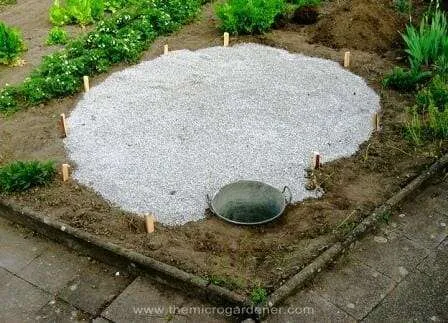
The base for this site has been pegged out, a gravel base laid and pond positioned.
STEP 3: Construct the wall structure
Using your edging material of choice, start laying your bricks/rocks on the outer edge. Work inwards to create a spiral shape. Allow about 0.5m (1.6 ft) width to plant into or adjust if making a smaller spiral.

To minimise your cost and time, use the dry stone wall method where rocks or bricks are laid on top of each other, overlapping for stability.
For a more formal look, use mortar or cement between your bricks or stones.
Tip: Save your best looking materials for the outside ‘face’ and those that will not be seen on the inside of the spiral.
If using heavy rocks or stone, you may prefer to dig a shallow trench around the circumference of the circle. Lay these rocks into it, on top of a layer of cardboard or weed mat to prevent weeds. If using the dry stone wall method, you may find it easier to add your organic materials as you go, to provide support. Adding organic materials at the end for the mortar method.
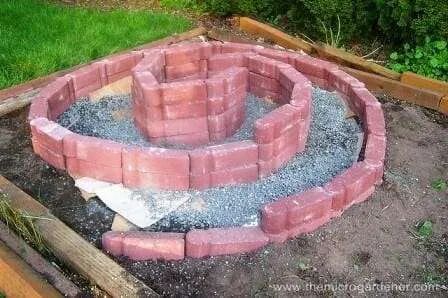 A small herb spiral being constructed with bricks inside a raised garden bed with cardboard and gravel added at the base.
A small herb spiral being constructed with bricks inside a raised garden bed with cardboard and gravel added at the base.
Once you have your basic shape laid out around the circumference, add a second tier of bricks. Remember, the outside ‘wall’ of your spiral is lowest (e.g. 2 bricks high or perhaps 1-2 rocks depending on size – enough to retain your soil).
 Use more bricks or rocks to build the internal spiral walls, gradually increasing the height as you work your way into the centre.
Use more bricks or rocks to build the internal spiral walls, gradually increasing the height as you work your way into the centre.The middle will usually end up about 1m (3 ft) high with a central planting area. It gradually tapers down in height on a light slope to the bottom. You can block it off or add your bog/pond at the base if using.

To minimise the quantity of organic materials required, you may prefer to add some rubble to the centre where the depth is greatest before adding your organic matter.
STEP 4: Add your Organic Materials and Soil Nutrients
This will be different, depending on what you have easy access to. Some people only add mulch or straw to their herb spiral and plant into pockets of compost. If you’re on a tight budget or this is all you have access to, then this system of ‘growing soil’ will work fine. Remember ‘dead dirt’ is unlikely to bring you a successful outcome!
“Like humans, plants thrive on good nutrition.” – Anne Gibson
Rather than buying in a trailer load of soil from your landscape yard, you can make your own soil teaming with living microorganisms. Soil that has a good structure (a crumbly fine texture that holds moisture well) is ideal for healthy productive plants.

To achieve this, add different kinds of organic matter that will break down over time, feeding your plants rather than just garden ‘dirt’ which tends to compact & provides little nutrition.
These organic ingredients are likely much cheaper than buying in soil too!
Affiliate Links: Your support of this site is appreciated!
Good sources of organic matter that will build soil fertility include:
- well rotted manure;
- mushroom compost or even better, your own compost;
- worm castings from your worm farm or available commercially;
- moistened Coir peat bricks or coco husk; and
- for lower layers use materials like leaf litter, well chopped prunings and dry grass clippings.
Sprinkle rock minerals (crusher dust from your landscapers is also suitable and very economical) and organic fertilisers as you add the organic matter to build in nutrients as a food source.
 Soil Nutrition: Adding plant food that will release nutrients slowly while you build the spiral will reduce maintenance to a minimum.
Soil Nutrition: Adding plant food that will release nutrients slowly while you build the spiral will reduce maintenance to a minimum.
If you have access to biodynamic preps, you may choose to add these too. To assist breakdown and ensure there is enough moisture, water in each layer with liquid seaweed. Expect some natural settling to occur.
 Tip: It’s a good idea to check the pH balance of your organic matter – it may be necessary to sweeten the soil with some dolomite lime if the pH is too high.
Tip: It’s a good idea to check the pH balance of your organic matter – it may be necessary to sweeten the soil with some dolomite lime if the pH is too high.
Moisture loving plants at the bottom of the spiral will thrive if you include some (optional) additional moisture holding ingredients. e.g. coconut fibre (coir peat), sphagnum moss, worm castings or some well aged compost (humus).
Affiliate Links: Your support of this site is appreciated!

Once your herb spiral is built, you will be ready to plant it out.
Herb Spiral How to Videos and Resources
These videos focus more on constructing the herb spiral structure, than building the soil. I think you will get a better idea watching several herb spirals being built. They all offer different perspectives and insights!
Watch how to build your soil to feed your plants in a herb spiral, to meet their individual needs. (The video quality is not great but the information is helpful!)
This video covers a Permaculture group building a herb spiral with straw and planting into pockets of compost.
This video shows a herb spiral made using rocks and soil.
Dean Chichelli from The Nature Learning Center shows how to build a Spiral Herb Garden. He mainly uses straw and then plants into pockets of compost at the end.
This last video shows how to build a very compact herb spiral with bricks.
Diagramatic technical specifications plan – Full size printable.
Tips for Building Your Herb Spiral
- To fill gaps in the perimeter curves of your spiral, use small, cut or broken bricks and stones.
- You can fill niches with ground covers like oregano or pennyroyal. Sphagnum moss can be pushed into gaps up the wall and a small amount of compost tucked inside to plant into. Or make a seed ball with some compost, a little clay and moist coconut fibre (coir peat) rolled up with seeds inside and push against the wall into the crevice. When the seeds are moist they will germinate and grow into the gaps.
- Finish with decorative and smaller stones, rocks or bricks at the top.
 For parks, playgrounds, schools and community gardens where you may want to build a larger spiral, adapt the design to build it on ground level instead. Allow enough space for a pathway alongside the planting area so instead of reaching in to the centre for easy access, you can walk around the spiral to pick your herbs.
For parks, playgrounds, schools and community gardens where you may want to build a larger spiral, adapt the design to build it on ground level instead. Allow enough space for a pathway alongside the planting area so instead of reaching in to the centre for easy access, you can walk around the spiral to pick your herbs.
- To add a water garden at the base, dig out a hole and add black plastic to line it. You can use any container that will hold sufficient water and grow water loving species like water chestnuts and cress. If you live in a dry climate, use the ‘pond’ as a reservoir to water the garden from.
Herb Spirals Before & After – Some Inspiration!
Check out my Herb Spiral photo album on Facebook for more inspiring ideas.
 LEFT: When spiral was first planted | RIGHT: After 12 months – depending what plants you grow, the edging may not matter!
LEFT: When spiral was first planted | RIGHT: After 12 months – depending what plants you grow, the edging may not matter!
Really cramped for space? You can still design a mini sized herb spiral!
 An alternative building method – with a pile of soil in the centre, then adding bamboo stakes & rock borders.
An alternative building method – with a pile of soil in the centre, then adding bamboo stakes & rock borders.
Gabion Herb Spirals
Since first posting the gabion herb spiral design, there has been incredible interest from all over the world in building them. The original image at the top that linked to Cara-Ornamentals is no longer working. Below I’ve listed some suppliers and resources that may be helpful if you’re interested in sourcing materials to build your own. Or search on “gabion wire baskets” or “wire mesh”:
- Gabion Stone Walls & Kits – Australia
- Permathene – Australia
- Geotas Gabion Cages – Australia
- Global Synthetics – Australia
- Gabion Baskets and Residential – USA
- iPafes Gabion Baskets – USA
- Gabion Supply – USA
- Riverdale Mills – USA
- Maccaferri Gabions – USA
- Devoran Garden Gabions – UK
- Brock White Gabion Baskets – Canada
- AlpenBau Ferrondo Round Baskets – Italy
- Gabion Baskets – South Africa
Tutorial Videos on Gabions
Learn how to make a narrow wire basket you can cut to size for your design using these techniques
Learn how to use free form galvanized wire to form a basket you can fill with stones
Learn how to assemble a gabion basket step by step
Ready to Plant your Herb Spiral?
In How to Plant out a Herb Garden, I share a herb plant list to make it easy for you to know what to plant where in your herb spiral and tips for laying it out.
Affiliate Links: Your support of this site is appreciated!
Some of the links in this post are “affiliate links.” This means if you click on the link and make a purchase, I will receive a small commission. I only recommend products or services I use personally or believe will add value to my readers. Please read my Disclosure Statement for more details.
Like this article?
Please share! Join my free Newsletter for more tips and all future articles.
© Copyright Anne Gibson, The Micro Gardener 2016. https://themicrogardener.com. All rights reserved.


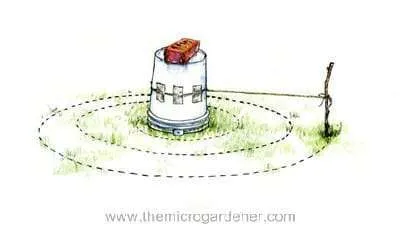
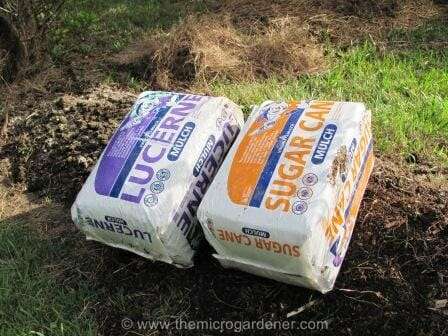
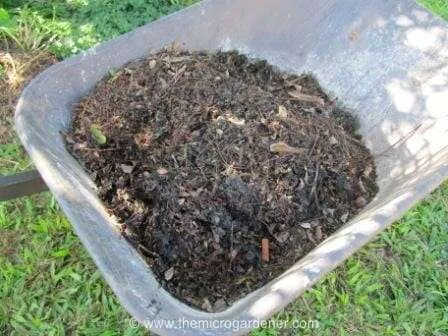








Researching building one for our garden in So. California. In various online sites, I see photos and diagrams showing the bottom drainage coming out either to the left or to the right. I see conflicting advice based on N vs. S hemisphere. Does it really matter which way an herb spiral drains? Why?
Hi Jerry
In reality, it probably won’t make too much difference as the size and volume of water is so small! It’s more a technical point.
This is a question sometimes raised and the answer is responded to in the publication Scientific American.
Can somebody finally settle this question: Does water flowing down a drain spin in different directions depending on which hemisphere you’re in? And if so, why?
“This question would seem to be one of simple physics, and yet it continues to engender sharp disagreements. The main problem here is the division between theory and practice: whereas in principle the earth’s rotation could affect the direction of draining water, in the real world that effect is probably swamped by other, less uniform influences.
Brad Hanson, a staff geologist with the Louisiana Geological Survey, presents the argument of why -in theory -water going down the drain would indeed spin in different directions depending on which hemisphere you’re in:
“The direction of motion is caused by the Coriolis effect. This can be visualized if you imagine putting a pan of water on a turntable and then spinning the turntable in a counterclockwise direction, the direction in which the earth rotates as seen from above the north pole. The water on the bottom of the pan will be dragged counterclockwise direction slightly faster than the water at the surface, giving the water an apparent clockwise spin in the pan. But if you were to look at the water in the pan from below, corresponding to seeing it from the south pole, it would appear to be spinning in a counterclockwise direction. Likewise, the rotation of the earth gives rise to an effect that tends to accelerate draining water in a clockwise direction in the Northern hemisphere and counterclockwise in the Southern.”
Fred W. Decker, professor emeritus of oceanic and atmospheric science at Oregon State University notes, however, that the Coriolis effect may actually have little to do with the behavior of real-world sinks and tubs:
“Really, I doubt that the direction of the draining water represents anything more than an accidental twist given by the starting flow. The local irregularities of motion are so dominant that the Coriolis effect is not likely to be revealed. An empirical test could help.”
Robert Ehrlich, a physicist at George Mason University, expands on these ideas:
“Do bathtubs drain in different directions in the two hemispheres? If you had a specially prepared bathtub, the answer would be yes. For any normal bathtub you are likely to encounter in the home, however, the answer is no.
“The tendency of a circulation in a fluid to develop in a clockwise direction in the Northern Hemisphere and a counterclockwise direction in the Southern Hemisphere can be traced to the earth’s rotation. Imagine a cannon fired southward from any latitude above the equator. Its initial eastward motion is the same as that at a point on the spinning earth. This initial eastward velocity is less than that at a point later in its trajectory, because points closer to the equator travel in a bigger circle as the earth rotates. Therefore, the cannon shell is deflected westward (to the right), from the perspective of a person standing on the earth. A gunner firing a cannon northward would find that the shell is also deflected toward the right. These sideways deflections are attributed to the Coriolis force, although there really is no force involved–it is just an effect of being in a rotating reference frame.
“The Coriolis force accounts for why cyclones are counterclockwise-rotating storms in the Northern Hemisphere, but rotate clockwise in the Southern Hemisphere. The circulation directions result from interactions between moving masses of air and air masses moving with the rotating earth. The effects of the rotation of the earth are, of course, much more pronounced when the circulation covers a larger area than would occur inside your bathtub.
“In your tub, such factors as any small asymmetry of the shape of the drain will determine which direction the circulation occurs. Even in a tub having a perfectly symmetric drain, the circulation direction will be primarily influenced by any residual currents in the bathtub leftover from the time when it was filled. It can take more than a day for such residual currents to subside completely. If all extraneous influences (including air currents) can be reduced below a certain level, one apparently can observe that drains do consistently drain in different directions in the two hemispheres.”
Finally, Thomas Humphrey, a senior scientist at the San Francisco Exploratorium, discusses in more detail the reasons why we do not see the Coriolis effect at work in the bathroom:
“There is an African country near the equator where entrepreneurs have set up two toilets, one just north of the equator, the other just south of it. For a fee, they will allegedly demonstrate that the toilets flush in opposite directions. It is only for show, however; there is no real effect. Yes, there is such a thing as the Coriolis effect, but it is not enough to dominate the flushing of a toilet–and the effect is weakest at the equator.
“The telling comparison is between the magnitude of the Coriolis effect and the initial amount of angular momentum in the water–that is, how much is it spinning anyway, regardless of the earth’s rotation. Coriolis acceleration at mid-latitudes is about one ten-millionth the acceleration of gravity. Because it is a very small acceleration, it needs a very long distance for it to produce an appreciable curvature–and hence directionality–to the motion. A toilet or sink is just not large enough. The Coriolis effect influences because wind velocities may be hundreds of times greater than the motions in a sink and because the distances involved are far larger than the tiny draining diameter in a sink or toilet.
“It is impossible to find a cup full of water that does not have some average net motion; it will always be going one way or the other, and that little amount of angular motion is enough to swamp the Coriolis effect. The net motion in the water becomes much more pronounced as the water is forced to move in toward the center of evacuation, causing the normally invisible flows in the water to become visible as the water nears the drain. The ultimate direction of that flow is random–it can go one way one time, the other way the next.
“If you run an experiment in your sink–fill the sink, then pull out the stopper–the water will almost always go down the same way, making you wonder if this is really a random effect. But you will find that the faucet is almost always off center or that there is some other asymmetry in the sink. As a result, filling the sink consistently gives it some net rotation in the same direction, which you see as the normal direction of evacuation. Toilets will always drain and fill the same way, for the same reason.”
I hope this helps!
[…] we had plans to construct a herb spiral; here’s a blog post about how that went. I found this article from The Microgardener helpful in planning and construction. My initial inspiration for the project […]
Thank you for this wonderful article. I am going to share it with our clients. One edit: Use agricultural/ dolomite lime if your pH is too low (acid).
If your soil pH is too high (alkaline) treating with sulfur will lower the pH. We have successfully lowered pH from 8.4 to 7.3 by adding good compost and copious amounts of worm tea over a year’s time.
Hope this helps!
I followed some of the links and found http://www.gabionbaskets.net for basket wire. eHow has a link on a tutorial from You Tube on how to make the baskets once you watch it you get a better idea on how to build clip 138 found at Hometalk.com
Thanks for sharing the link Cecilia. This is the link to the video on putting together Residential Gabion Baskets.
Hi I have a stump in my yard I would like to put flowers in that looks like that would work I love it
Thank you for the beautiful spiral herb garden, mx
Be VERY careful when using bamboo for anything, if will make itself quite at home and can spread faster than a juicy rumor in church.
What a beautiful website, I spent some time clicking around this afternoon and fell in love, thank you Judy
Thanks so much for your feedback – I hope you found what you’re looking for. Let me know if you need help with something specific. 🙂
I was wondering…I have a air conditioner hose that spews water outside. Could I put this hose so it drains on my herbs or is there something in there that would harm them. It seems like a great way to use the water.
Thanks!
Hi Judy
Thanks for your question! We collect the water from our air conditioner hose outlet in a small container and reuse on the adjacent garden (as we do with the outlet on our hot water heater). The water is from internal moisture (humidity) from your home – I can’t think of any reason why you shouldn’t reuse this valuable resource! Great thinking. 🙂
I was wondering if there were instructions for making the small one on top?
Hi Joey
The construction method is the same for all herb spirals but if you are referring to the first pic with gabion stone walls, there are links just below the photo to how to construct these specifically. That particular design comes as a kit however you can make your own gabion walls for your herb spiral following the other links and video tutorials. Hope this helps. Let me know if you need further assistance! 🙂
How do the unsupported walls do in northern climates? Do the walls tend to get pushed outwards with frost heaves? Also shouldn’t you plan to make the spirals small enough that you can reach the top tier without having to tread on the lower tiers? I love this idea!!
Hi Jill
Herb spirals use a raised garden bed design and plants tend to be more vulnerable to frost damage where cold air is in depressions or close to the ground – so they are in fact one way to help protect your plants by insulating them up higher! Spiral gardens are also easy to cover by throwing a sheet or other lightweight material over the top during the night and removing in the morning so the plants can get the warmth of the sun during the day. If you are concerned about the wall strength, rather than using the dry stone wall method, you could use cement to lock your rocks, pavers or materials into place.
Regarding frost heaves, there are a number of factors that cause this including the amount of soil moisture and soil type. However, you can also take some preventative actions including adding compost, sand and mulch as amendments but also reduce soil moisture when frost is due by managing your watering (See ‘How to Protect Your Plants from Frost Damage‘). “Wet soil will hold more heat than soil that is dry. However, do not saturate the plants while the temperatures are extremely low, as this will result in frost heave and ultimately injure the plants. Light watering in the evening hours, before temperatures drop, will help raise humidity levels and reduce frost damage.”
There’s also a good article that explains in more detail ‘Protecting against frost heave‘ and this may help you plan your project by taking some additional precautions in your climate.
Finally, yes the design details are outlined in Part 1 of this series of 3 articles on Herb Spirals. You can check out the full details on width so you can reach easily in Part 1. Part 3 provides you with tips on planting.
Hope this helps Jill! 🙂
I saw the gabion walled herb spiral on Facebook and I must say, it’s amazing! A friend and I want to make them for our yards, but she has a concern about the top plant not getting enough water. Is this a problem we need to be concerned with? Also, I read through the instructions for making the other varieties of spiral gardens. They said to put uninked cardboard down as a base. Is this what we would need for the smaller one we are considering making? Is there anything inside the tall section other than soil? We want to make sure we do it correctly! Thank you so much for your help and your website! Have a MARVELOUS day!
Hi Lyla
Thanks for your feedback. I would suggest also reading the first article in this series ‘15 Benefits of a Herb Spiral in Your Garden‘ as this explains how the watering works in this design. The idea is to select plants for the top that enjoy a sunny dry micro climate and those that need more moisture at the bottom (see part 3 article ‘How to Plant out a Herb Garden‘) for more tips on choosing specific herbs.
The idea of the cardboard is simply as a natural weed suppressant so you can build straight on top of lawn. If you are building on a hard surface, there’s no need for this. Alternatively you could use weed mat, gravel or another material of your choice. This is just a basic ‘recipe’ you can amend. In the centre of the spiral, to minimise the need for a lot of soil if you only want to plant fairly shallow rooted herbs or perennials, you can also add rubble to the bottom and just fill the top 30cm (1 ft) or so with soil/compost. This keeps the cost down. If however you want to plant say a bay tree in the top, I’d leave more room for the roots so would add the nutrition up the centre. It all depends on your plant choice and budget! Hope this helps. If you haven’t already, check out the categories on the left of the page for more design ideas and subscribe to my free newsletter for future tips. Hope you enjoy your herb spiral project.
Thank you for the inspiring site. My wife wants one now so I guess i have my work cut out for me this spring. lol
Glad you have been inspired Chuck! Wives have a way of encouraging their husbands to manifest great ideas. I’m sure your herb spiral will be a feature for many years to come and an enjoyable project. Every one I’ve been involved in has been different which is why they are so fascinating! Have fun and please share a pic when it’s done.
Hi Annie, another fantastic post and one that is particularly pertinent to what we are doing on Serendipity Farm at the moment. Steve is going to build me a gabion walled herb spiral to grow next to our new veggie beds and this was an incredible find! Cheers for the idea and for the prototype to work from 🙂
Great that the timing and info is useful Fran. As mentioned in the comment to Caron, here are some basic instructions for making a gabion wall – you can just curve the wire to the shape of a herb spiral. Your place must be amazing now! If I ever get to Tassie I’d definitely love to catch up and see all the brilliant projects you and Steve are doing.
thank you i will do x:)
Make your own 4 step guide vertical herb spiral garden – can you send me the instructions how to build the vertical one made out of chicken wiring please? I be very grateful as I would like to build one for my garden.
Hi Caron
If you click the image (http://www.caras-ornamentals.com/id2.html) in the post, it will link you to the website that sells the materials for this design. You can buy direct if you are in this location or otherwise perhaps source the same materials in your area and make your own. This style of herb spiral is made with Gabion (or stone filled) walls. It is a more expensive design but a permanent feature and looks amazing.
Here are some basic instructions for making a gabion wall – you can curve the wire to the shape of a herb spiral. There are also good instructions in these other posts:
http://blondemafia.blogspot.com.au/2010/10/how-do-you-make-gabion.html
http://gardendrum.com/2012/04/21/how-to-build-a-gabion-wall/
Hope this helps! Have fun. 🙂
A great idea, and easy to follow.
Thanks Jean! Hope this will inspire a whole new generation of gardeners enthralled with herb spirals. As a permanent garden feature, they also add value to property! 🙂